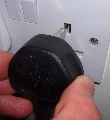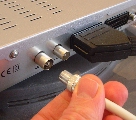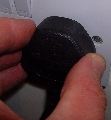My Freeview box has no EPG, is blank on FIVE, ITV3, ITV4, ITV2+1, has no sound o
 Brian Butterworth published on UK Free TV
Brian Butterworth published on UK Free TV To deal with the problem you must clear the channel list completely and then rescan - if your box has it in the menus, please the 'installation menu' to do an initial scan or a reset to factory settings or First Time Installation. You MUST delete the entire existing list of channels. On most boxes this technique can be also be used:
Try this:
1) unplug your Freeview box (or idTV) from the mains;

2) unplug the aerial from the Freeview box by disconnecting the cable from the 'RF in' socket;

3) wait 30 seconds;
4) plug Freeview box (or idTV) mains back in;

5) do a complete scan for channels - it will fail without the aerial. (This may be in the installation or initialization menu, and is distinct from any 'add channels option'). Once this is done your channel line up should be empty;

6) reinsert aerial by reconnecting to the 'RF in' connection;

7) do a complete scan for channels again.

The Freeview channel line-up provided by six "multiplexes" - each of which carry five or more TV channels, radio channels, text services and EPG data. In this diagram each ROW represents a multiplex. If you are still missing a whole multiplex (ie everything on the row) you may need to replace your aerial with a wideband type, purchase a larger aerial or you may have interference from a VCR, games console, Sky Digibox or similar.
9:52 AM
I am not sure how relevant it is but I notice the channels I am missing are on COM4, COM5 and COM6. I have just phoned Digital UK and they tell me there is no known issues with Sandy Heath, so that leads me back to thinking its an aerial problem but how can the aerial be working for some groups of channels and not others?, especially when it received all channels less than a week ago? totally baffled of Northampton.
| link to this comment |
Rog: The three Sandy Heath COM multiplexes are "out of group" as far as the old four analogue channels are concerned.
This means that where such an aerial is fitted, its senstivity at the frequencies used by the COMs will be less than that of the other (Public Service) channels.
The four analogue channels were on Group A channels (frequencies). Group A is the bottom third of the band. Consequently, Group A aerials were fitted whose sensitivity is best on those channels and drops off on higher channels.
The COMs are at the high end of Group B and this Group is the middle third of the band.
Prior to 9th May, COM4 was in a channel in Group A, so such an aerial would probably have worked.
A Group A aerial isn't forced to mean no reception of the COMs. It will mean at least lower strength being indicated on those channels, but with digital strength isn't so important (it's quality that matters).
So long as the signal is strong enough to be above the threshold that the receiver requires to resolve a picture, then it will work. And so long as it is far enough above that threshold that any natural reduction in strength (e.g. caused by the weather) doesn't put it under, then there will be reliable reception.
-----
COM4 is on UHF channel 51, COM5 is on C52, and COM6 is on C48.
If your receiver has manual tuning, then try manually tuning to these three UHF channels. Some devices give more clues than others. Some will give a strength for a chosen channel and if yours works like that, then it might say that there is a signal there, but that it is too weak to resolve a picture. Or it might be sufficient and allow you to add missing services.
If you have more than one receiver, then it might be worth trying others due to the different functionality of devices that I mentioned.
You could try doing this with and without the aerial fed through other device(s). For example, if you have a TV with built-in Freeview and a Freeview box (e.g. recorder), then try tuning the TV with the aerial looped through the recorder and then with it directly to the TV.
Once you have a device tuned, then don't retune it if you then get "no signal" on some or all COM channels (e.g. if you change the configuration of the aerial leads). In that case the receiver is tuned and it is an issue with the signal fed to it.
If you have a booster, then try with and without. The stronger strength of signals after switchover means that some boosters are not needed now, and if used could give too much signal. With digital, too much signal will be indicated by receivers as low or no signal (just the same as low or no signal).
| link to this comment |
11:18 AM
Northampton
Thanks for the reply Dave - I only have one TV, Freeview is built into the TV and I have no booster. I did try manually tuning into channels 51, 52, and 48 this morning and the message was "no signal" As far as I can see the aerial on the roof looks just as normal, so not moved or anything. . .
| link to this comment |
Rog's: mapR's Freeview map terrainR's terrain plot wavesR's frequency data R's Freeview Detailed Coverage
Rog: I'm inclined to suspect that you have a Group A aerial and that it isn't sufficient for the out of group COM channels.
The solution is probably a replacement aerial of the "wideband" type. Alternatively, a second aerial for higher frequency channels, combined (using a diplexer) with your existing aerial.
| link to this comment |
1:18 PM
Northampton
Dave: I'm sure you are right about the aerial, it is a old aerial, but there is just one thing I don't get; how come even though it is old it was good enough to receive the channels less than a week ago but not now?
| link to this comment |
Rog's: mapR's Freeview map terrainR's terrain plot wavesR's frequency data R's Freeview Detailed Coverage
Rog: I can't explain why you may have received all channels; there would seem to be no logical explanation.
The full list of Freeview channels can be found here: DMOL Post-DSO Multiplex Channel Allocations
Those with a bullet and grey background in the "E" (England) column are those which apply.
Prior to 9th May, you could probably pick up COM4 because it was within the frequency range of your aerial (i.e. "in group").
COM5 adopted its current frequency on 23rd November and COM6 did so on 14th September (both last year).
With analogue, every transmitter used four channels. With the full Freeview service, there are six channels required. Most transmitters have been given channels that are within the range of frequencies that former analogue aerials are likely to work, which means that existing aerials will work fine.
In some cases, however, including with Sandy Heath, this has not been possible and hence aerials may need to be replaced.
The reason for the retunes is because not all transmitters switch at the same time and therefore in some cases there is a delay before certain channels become available. Some have restricted coverage and/or use temporary channels until their final one becomes available.
Following the retune on 9th May, COM4 is now on C51. The wait was due to the fact that Hemel Hempstead was using it until it switched over to digital in April.
| link to this comment |
4:07 PM
Chatham
How much of a boost will they put through after switchover? I am so sick of pixellating etc and losing signal - Just for the exact moment where I am listening to something - It's like it knows which words to cut out for me LOL
I really hope my signal will be better after switchover - My aerial being lower than people who live in houses etc already cos I am in a bungalow....
| link to this comment |
Sarah's: mapS's Freeview map terrainS's terrain plot wavesS's frequency data S's Freeview Detailed Coverage
7:18 PM
Sarah C: Bluebell Hill will transmit at 20kw on each mux, up from 3kw-4kW currently. This is quite a generous increase, as using the usual calculation to cover the existing analogue service area it would require 6kW.
| link to this comment |
7:20 PM
Halifax
Rog,Northampton.Is your aerial coloured red at its tips,if it is (most likely as you stated it's an old aerial) then it is a group A aerial.All of Sandy Heath's public service broadcast multiplexes BBCA (frequency 27),D3+4 (frequency 24),BBCB (HD) (frequency 21) fall within the group A band,while the commercial multiplexes you mentioned you're unable to receive via manual scanning,SDN (frequency 51),ArqA (frequency 52),ArqB (frequency 48) fall both within the group B (yellow tipped aerials) and also the group C/D (green tipped aerials) bands.
The options you have are :-
1-Retain your current group A (red tip) aerial and get a diplexer (channel 38 diplexer) and a second preferably group B (yellow tip) aerial to receive SDN,ArqA & ArqB multiplexes further up the band.
2-Change to a group W wideband (black tip) aerial either on its own or diplex the group W wideband with your present group A aerial.
3-Or change to a superior quality semi-wideband group K (grey tip) aerial optimised for the lower/middle band frequencies between 21-48,preferably an X-Beam XB16K aerial which can work right down to channel 55,or a superior quality Yagi 18K which can also work right down to channel 55 too,but only proceed with this option if you were to buy a group K aerial from reputable aerial retailers such as ATV (Aerials and Television) of Sheffield,they are IMHO the best in the UK today,forget the rest.
As for ATV of Sheffield i would strongly recommend looking up their website and retain it as a shortcut on your PC (i have already since September 2011),as well as purchasing any new aerial,cable,co-ax plug,diplexers,etc,from ATV of Sheffield on only from them if you were to decide on upgrading your aerial and related equipment as such.
| link to this comment |
Mark's: mapM's Freeview map terrainM's terrain plot wavesM's frequency data M's Freeview Detailed Coverage
7:21 PM
Chatham
*Sarah C: Bluebell Hill will transmit at 20kw on each mux, up from 3kw-4kW currently. This is quite a generous increase, as using the usual calculation to cover the existing analogue service area it would require 6kW.**
I don't really understand that (very non technical me) But - If you say it is good then I shall eagerly await switchover in the hope that I wont hafta watch TV in little squares - LOL Thanks KMJ!
| link to this comment |
Sarah's: mapS's Freeview map terrainS's terrain plot wavesS's frequency data S's Freeview Detailed Coverage